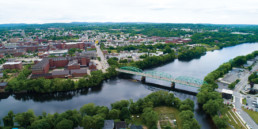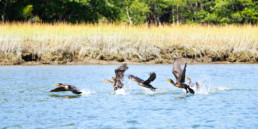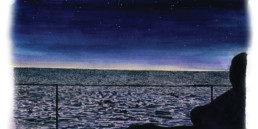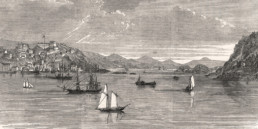Maine Islands
Paintings From the Farnsworth Collection
The Farnsworth Art Museum’s collection of approximately 15,000 works focuses on American art from the 18th century to the present, with a special emphasis on artists who have lived or worked in Maine. Since the mid-nineteenth century, the state has been both host and inspiration to many of America’s most noted painters. Drawn here by Maine’s physical beauty, they found subjects for their work that sustained them and, in some cases, defined their careers. The museum’s earliest acquisitions thus often depicted not only Maine’s scenic coastline, but its stunning islands as well.
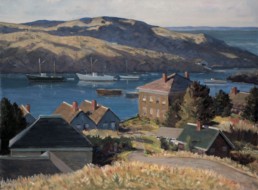
Jan marinus Domela (1896-1973)
Monhegan Island, 1938
Oil on canvas
Bequest of Mrs. Elizabeth B. Noyce, 1997
Monhegan Island shows the village, harbor, and Manana Island in the distance under the bright sunlight and dramatic shadows of a late afternoon, during a time when Domela was painting with friend and resident island painter Jay Hall Connaway.
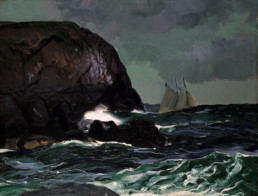
George Wesley Bellows (1882-1925)
Beating Out to Sea, 1913
Oil on board
Museum Purchase, 1945
One of the earliest acquisitions by the Farnsworth Museum, Beating Out to Sea is among the hundred works George Bellows painted on Monhegan Island during the summer and fall of 1913. This study reveals the immediacy of his experience with the sea, and energy that he felt and so quickly expressed with brush on board. This painting captures an instant but suggests ever-changing color, the sound of pounding, deep, cold, water against slippery hard rock, and the feel of salt spray and heavy wet fog.
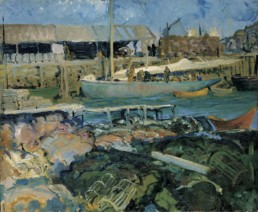
George Wesley Bellows (1882-1925)
The Fish Wharf, Matinicus Island, 1916
Oil on panel
Bequest of Mrs. Elizabeth B. Noyce, 1997
In the autumn of 1916 Bellows and his wife Emma stayed on Matinicus Island, a thriving fishing community 20 miles off the Maine coast. Bellows completed several paintings and many sketches of this productive trip. Later, he painted scenes from memory, and wrote that it is the artist who makes life more interesting or beautiful, more understandable or mysterious, or probably, in the best sense, more wonderful.
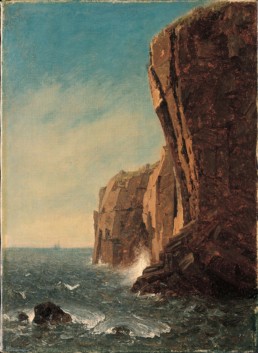
Sanford Robinson Gifford (1823-1880)
Rocks at Porcupine Island near Mt. Desert, 1864
Oil on canvas
Museum purchase, 1998
Sanford Robinson Gifford focused on the fleeting effects of light during his painting trips abroad and in the United States. While Civil War battles raged elsewhere, Gifford joined fellow painter Jervis McEntee on a three-week visit to Mount Desert Island, filling sketchbooks with impressions of the landscape made during treks from a rustic cabin on Cadillac Mountain. When he returned to his New York studio, Gifford made oil studies from his sketches of the island, one of which resulted in this painting. He rendered a sailboat in the distance against a cloudless blue sky, but in a single brush stroke, suggested in the foreground a tiny dinghy, buffeted upon swirling cold waters at the foot of a sheer cliff. Smashed by whitecaps, this unmoving rock at the edge of Porcupine Island appears too powerful to crumble from encroaching plant life or the force of salty spray.
Raphael Soyer painted The Boatyard on the island of Vinalhaven, located just off the coast of Rockland, where he summered from 1957 until the end of his life. Vinalhaven’s attraction was, in Soyer’s words, that it was “naturally picturesque” and that it “acquired a peculiar charm that semi-abandonment and isolation give.” He established himself as a painter of the gritty urban scene in New York in the 1920s and 1930s, featuring ordinary men and women in their homes, at work, and at leisure, but landscape subjects became more frequent in his work upon his arrival in Maine.
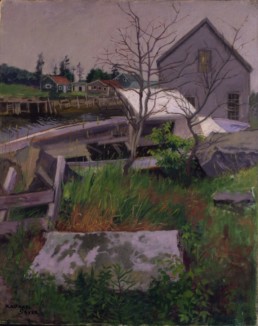
Raphael Soyer (1899-1987)
The Boatyard, Vinalhaven, c. 1950
Oil on canvas
Gift of Mrs. Elizabeth B. Noyce, 1996
© Estate of Raphael Soyer, courtesy of Forum Gallery, New York, NY
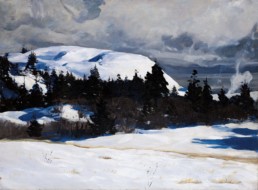
Rockwell Kent (1882-1971)
Maine Coast, c. 1907
Oil on canvas
Bequest of Mrs. Elizabeth B. Noyce, 1997
Rockwell Kent, one of several painters to follow the advice of the influential American painter and teacher Robert Henri, came to paint on Monhegan as early as 1905. Maine Coast exhibits Kent’s graphic vision and command of color in his emphasis of the stark beauty of island snow under a wintry sky. Kent financed his years at his self-built Monhegan home and studio by working alongside islanders as a lobsterman, well driller, and carpenter. His experience of the island’s dramatic sea and land in all seasons inspired him to embark on decades of far-flung northern adventures to Newfoundland, Alaska, Greenland and Ireland before returning to Monhegan 35 years later.
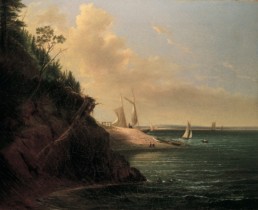
Alvan Fisher (1792-1863)
Sutton Island, Mount Desert, c. 1848
Oil on canvas
Museum purchase, 1960
Alvan Fisher painted a number of romantic views of Mount Desert Island based on sketches he made during a tour of the area in 1847 and 1848. This was at a time when dramatic depictions of Mount Desert scenery were causing a surge of artistic and popular interest in the island. Fisher emphasized the island’s rugged beauty, somewhat tempered by human intervention. In Sutton Island the darker shape of the foreground cliff acts as a framing device, like a theater curtain that is swept aside, to reveal the sailboats and tiny figures bathed in sunlight. Fisher’s scene is symbol and promise of growing tourism along Maine coastal waters.
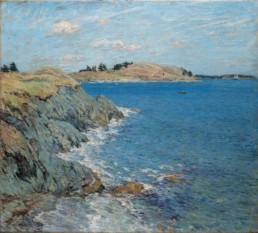
Willard leroy Metcalf (1858-1925)
Ebbing Tide, Version 2, 1907
Oil on canvas
Gift of the Estate of Sylvia Benson Lawson, 1982
Willard Metcalf was noted for his ability to evoke a sense of the actual experience of place in his paintings. The scene of pale rocky islands set against sparkling blue water and bright sky in Ebbing Tide exemplifies the best of Maine’s summer vistas on Penobscot Bay, while betraying little of the unhappiness felt by its author. Painted from the North Haven dock of friend and fellow artist Frank Benson during a time of retreat from his broken marriage, Metcalf’s view depicts the Fox Island thoroughfare between North Haven and Vinalhaven islands. Metcalf dedicated the seascape to Benson, whose caring family helped him through his period of despondency.


